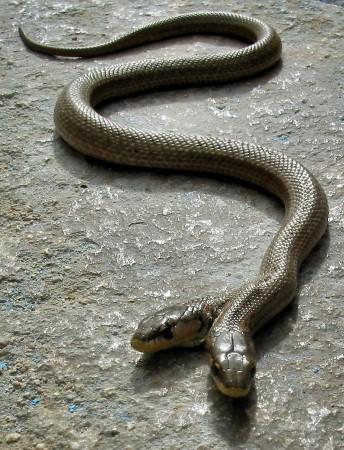
A recent study revealed that wild female snakes can give birth without having any contact with male snakes, disclaiming the long-held belief that asexual reproduction or "virgin births" can happen only among invertebrates.
Warren Booth, a molecular ecologist at the University of Tulsa, Oklahoma, cited the discovery of the first proved case of asexual reproduction in vertebrates in the journal "Biology Letters". Though such births have been identified in sharks, chickens and pit vipers, it was considered extremely rare for species like wild snakes which were believed to have sexual reproduction.
"Until this discovery, facultative parthenogenesis - asexual reproduction by a normally sexual species - has been considered a captive syndrome," Booth said according to scientific website LiveScience.
The study revealed the possibility of virgin births in the copperhead (Agkistrodon contortrix) and cottonmouth (Agkistrodon piscivorus).
"In these populations, males are relatively common, hence females were not restricted from access to males, and therefore isolation from males is not a driving factor for parthenogenic reproduction (virgin births) here," Booth added.
For this particular study the researchers congregated the genetic samples of copperheads from Connecticut, and cottonmouths from Georgia. They also collected 22 litters of copperheads and 37 litters of cottonmouths, of both mother and offspring. The DNA analysis of these litters suggested that the offspring were produced without mating.
"We just sat there stunned at the discovery," Booth told LiveScience. "This is something that we always believed existed, but in order to investigate it, it would take a massive amount of work in the field. ... To detect it in both species in our first attempt was astounding."
The research was done in collaboration with Charles Smith and Pam Eskridge of the Copperhead Institute and Wofford College, S.C. Shannon Hoss, a graduate student at San Diego State University, helped to analyze a larger amount of data.
However, the researchers could not decipher the reason behind such births - whether the female snakes decides to reproduce this way or if there are any other factors which trigger the female vertebrae to have virgin births. The researchers said that the frequency of the births is what exactly surprised them.
"I think the frequency is what really shocked us," Booth said. "In the copperhead population, we detected one instance in 22 litters, whereas in the cottonmouths, it was one in 37 litters. Essentially, somewhere between 2.5 and 5 percent of litters produced in these populations may be resulting from parthenogenesis. That's quite remarkable for something that has been considered an evolutionary novelty, even by me up until this finding."
According to LiveScience, the researchers are looking forward to see how this virgin offspring survives and future research will also focus on virgin births in other species such as water snakes in Oklahoma.





!['Lip lock, pressure, pyaar': Vidya Balan- Pratik Gandhi shine in non-judgmental infidelity romcom Do Aur Do Pyaar [ Review]](https://data1.ibtimes.co.in/en/full/797104/lip-lock-pressure-pyaar-vidya-balan-pratik-gandhi-shine-non-judgmental-infidelity-romcom.jpg?w=220&h=138)







